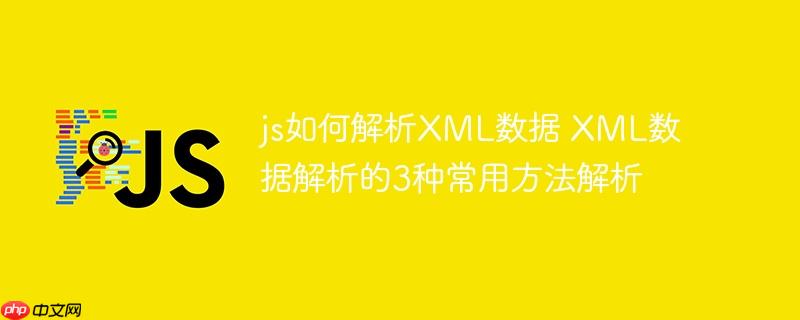解析 xml 数据在 javascript 中可通过三种主要方法实现:domparser、xmlhttprequest 和第三方库。1.domparser 是浏览器内置的解析器,通过 parsefromstring() 方法将 xml 字符串转换为 document 对象,便于操作 xml dom;2.xmlhttprequest 可用于从服务器获取并解析 xml 文件,设置 responsetype 为 "document" 后通过 responsexml 获取解析后的 document 对象;3.第三方库如 jquery 提供更简洁的 api,使用 $.parsexml() 方法简化解析和数据提取过程。此外,处理命名空间需使用 getelementsbytagnamens() 和 getattributens() 方法;复杂结构可通过递归函数遍历元素和属性;错误处理则应检查 parsererror 元素以判断解析是否失败。每种方法各有适用场景,开发者可根据需求选择合适方案。

直接使用 JavaScript 解析 XML 数据,核心在于将 XML 字符串转换为 JavaScript 可以操作的对象。通常有三种常见方法:DOMParser、XMLHttpRequest (配合 responseXML) 以及使用第三方库(例如 jQuery)。选择哪种方法取决于你的具体需求,比如是否需要兼容老版本浏览器,或者是否需要更便捷的 API。

DOMParser XMLHttpRequest 第三方库

DOMParser 是浏览器内置的 XML 解析器,使用起来相当直接。首先,你需要创建一个 DOMParser 实例,然后调用其 parseFromString() 方法将 XML 字符串转换为 Document 对象。之后,你就可以像操作 HTML DOM 一样操作 XML DOM 了。
const xmlString = `<bookstore>
<book category="cooking">
<title lang="en">Everyday Italian</title>
<author>Giada De Laurentiis</author>
<year>2005</year>
<price>30.00</price>
</book>
</bookstore>`;
const parser = new DOMParser();
const xmlDoc = parser.parseFromString(xmlString, "text/xml");
const title = xmlDoc.getElementsByTagName("title")[0].childNodes[0].nodeValue;
console.log(title); // 输出 "Everyday Italian"需要注意的是,如果 XML 格式不正确,parseFromString() 方法可能会返回一个包含错误信息的 Document 对象。因此,在使用前最好检查一下 xmlDoc.getElementsByTagName("parsererror") 是否为空。

如果你需要从服务器获取 XML 数据,XMLHttpRequest 是一个不错的选择。设置 responseType 为 "document" 可以让浏览器自动将响应解析为 XML Document 对象。
const xhr = new XMLHttpRequest();
xhr.open("GET", "books.xml", true);
xhr.responseType = "document";
xhr.onload = function() {
if (xhr.readyState === 4 && xhr.status === 200) {
const xmlDoc = xhr.responseXML;
const title = xmlDoc.getElementsByTagName("title")[0].textContent;
console.log(title);
}
};
xhr.send();这里,books.xml 应该是一个 XML 文件,放置在你的服务器上。注意处理 readyState 和 status,确保请求成功完成。textContent 属性是获取元素文本内容的更简洁的方式,替代了 childNodes[0].nodeValue。
像 jQuery 这样的库提供了更简洁的 API 来处理 XML 数据。虽然 jQuery 主要用于 HTML 操作,但它也能很好地处理 XML。
const xmlString = `<bookstore>
<book category="cooking">
<title lang="en">Everyday Italian</title>
<author>Giada De Laurentiis</author>
<year>2005</year>
<price>30.00</price>
</book>
</bookstore>`;
const xmlDoc = $.parseXML(xmlString);
const $xml = $(xmlDoc);
const title = $xml.find("title").text();
console.log(title); // 输出 "Everyday Italian"$.parseXML() 将 XML 字符串转换为 XML Document 对象,然后你可以使用 jQuery 的选择器和遍历方法来查找和提取数据。这种方式通常更简洁,代码可读性也更高。
XML 命名空间用于避免元素名称冲突,特别是在处理来自不同来源的 XML 数据时。在 JavaScript 中处理命名空间需要使用特定的方法,例如 getElementsByTagNameNS() 和 getAttributeNS()。
const xmlString = `<root xmlns:prefix="http://example.com">
<prefix:element attribute="value">text</prefix:element>
</root>`;
const parser = new DOMParser();
const xmlDoc = parser.parseFromString(xmlString, "text/xml");
const element = xmlDoc.getElementsByTagNameNS("http://example.com", "element")[0];
const attributeValue = element.getAttributeNS(null, "attribute"); // null 表示没有命名空间的属性
const textContent = element.textContent;
console.log(attributeValue); // 输出 "value"
console.log(textContent); // 输出 "text"getElementsByTagNameNS() 方法接受命名空间 URI 和本地名称作为参数。getAttributeNS() 方法也类似,但第一个参数也可以是 null,表示获取没有命名空间的属性。
处理复杂的 XML 结构可能需要递归遍历 XML 树。你可以编写一个递归函数,该函数接受一个 XML 元素作为参数,并处理该元素的属性和子元素。
function processElement(element) {
console.log("Element Name:", element.nodeName);
for (let i = 0; i < element.attributes.length; i++) {
const attribute = element.attributes[i];
console.log("Attribute:", attribute.name, "=", attribute.value);
}
for (let i = 0; i < element.childNodes.length; i++) {
const child = element.childNodes[i];
if (child.nodeType === Node.ELEMENT_NODE) {
processElement(child); // 递归调用
} else if (child.nodeType === Node.TEXT_NODE) {
console.log("Text Content:", child.textContent.trim());
}
}
}
const xmlString = `<root>
<element attribute="value">
Some text
<child>More text</child>
</element>
</root>`;
const parser = new DOMParser();
const xmlDoc = parser.parseFromString(xmlString, "text/xml");
processElement(xmlDoc.documentElement); // 从根元素开始这个例子展示了如何递归遍历 XML 树,并处理元素、属性和文本内容。根据你的具体需求,你可以修改 processElement() 函数来执行不同的操作。注意 trim() 方法用于去除文本内容中的空白字符。
XML 解析过程中可能会遇到各种错误,例如格式不正确、缺少必需的元素或属性等。为了确保你的代码能够正确处理这些错误,你需要进行适当的错误处理。
const xmlString = `<bookstore>
<book category="cooking">
<title lang="en">Everyday Italian
<author>Giada De Laurentiis</author>
<year>2005</year>
<price>30.00</price>
</book>
</bookstore>`; // 缺少闭合标签
const parser = new DOMParser();
const xmlDoc = parser.parseFromString(xmlString, "text/xml");
const errorNode = xmlDoc.getElementsByTagName("parsererror")[0];
if (errorNode) {
console.error("XML 解析错误:", errorNode.textContent);
} else {
const title = xmlDoc.getElementsByTagName("title")[0].textContent;
console.log(title);
}在这个例子中,XML 字符串缺少一个闭合标签,导致解析错误。通过检查 xmlDoc.getElementsByTagName("parsererror") 是否存在,我们可以判断是否发生了错误。如果存在错误,我们可以输出错误信息,而不是尝试访问不存在的元素。
以上就是js如何解析XML数据 XML数据解析的3种常用方法解析的详细内容,更多请关注php中文网其它相关文章!

每个人都需要一台速度更快、更稳定的 PC。随着时间的推移,垃圾文件、旧注册表数据和不必要的后台进程会占用资源并降低性能。幸运的是,许多工具可以让 Windows 保持平稳运行。




Copyright 2014-2025 https://www.php.cn/ All Rights Reserved | php.cn | 湘ICP备2023035733号